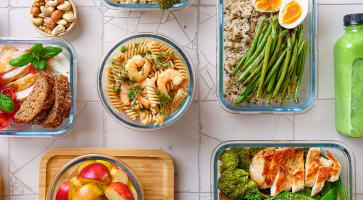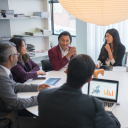Introduction to Meal Planning
Introduction to Meal Planning:
Meal planning is a popular concept that involves organizing and preparing meals for a certain period of time, typically a week. It is a crucial aspect of maintaining a healthy relationship with food as it helps individuals make mindful and intentional choices about what they eat. In today’s fast-paced world, meal planning has become an essential tool for individuals looking to prioritize their health and save time in the kitchen.
The main goal of meal planning is to simplify the process of deciding what to eat by providing structure and organization. By planning ahead, individuals can avoid impulsive food decisions, which often lead to unhealthy eating habits. Additionally, meal planning allows for better control over portion sizes and ingredients used in meals, making it easier to stick to dietary goals.
One of the key benefits of meal planning is its ability to promote healthier food choices. When creating a weekly meal plan, individuals have the opportunity to incorporate more nutrient-dense foods into their diet such as fruits, vegetables, lean proteins, and whole grains. This not only provides balanced nutrition but also helps reduce the consumption of processed and convenience foods that are high in calories, unhealthy fats, and added sugars.
Another advantage of meal planning is its cost-effectiveness. By having a well-thought-out grocery list based on planned meals for the week, individuals can avoid overspending on unnecessary items or impulsively buying takeout meals. This not only saves money but also reduces food waste since ingredients are used efficiently throughout the week.
In addition to health and financial benefits, meal planning can also help alleviate stress related to cooking dinner after a long day at work or school. With all ingredients prepped ahead of time according to the weekly plan, cooking dinner becomes less daunting and more manageable.
Introducing meal planning into your routine can greatly improve your relationship with food by promoting mindful eating habits and reducing stress around mealtime decisions. In this blog series on “Meal Planning Made Easy”, we will explore various tools and strategies that can help you cultivate a healthy relationship with food through meal planning.
Why Cultivating a Healthy Relationship with Food is Important
Why Cultivating a Healthy Relationship with Food is Important
Food is not just something we consume to survive; it is woven into the fabric of our daily lives and can have a significant impact on our physical, mental, and emotional well-being. Therefore, cultivating a healthy relationship with food is crucial for maintaining overall health and happiness.
Firstly, having a healthy relationship with food means being mindful of what we eat. It involves paying attention to the types of food we consume, where they come from, and how they make us feel. By being more aware of our food choices, we can make informed decisions about what nourishes our bodies best and avoid mindless eating habits that may lead to unhealthy weight gain or poor nutrition.
Furthermore, developing a positive relationship with food also involves understanding the role it plays in our emotions and mental state. Many people turn to food as a source of comfort or reward when dealing with stress or difficult emotions. However, this type of emotional eating can be harmful if it becomes an unhealthy coping mechanism. By cultivating a healthy relationship with food, we can learn to listen to our bodies' signals and differentiate between true hunger and emotional triggers for eating.
Additionally, building a healthy relationship with food promotes self-care and self-love. When we view food as fuel for our bodies rather than something to restrict or control, we are more likely to prioritize making nutritious choices that support our well-being. This mindset shift can also help individuals break free from restrictive diets that often lead to disordered eating patterns.
Moreover, cultivating a healthy relationship with food can improve one's overall quality of life by promoting balance and moderation in eating habits. Rather than following strict rules or fad diets that often promote an "all-or-nothing" mentality towards certain foods, creating balance allows individuals to enjoy all types of foods without guilt or shame.
Developing a positive connection with food has been linked to better physical health outcomes such as reduced risk of chronic diseases and improved energy levels. When we nourish our bodies with a variety of whole, unprocessed foods, we provide it with the necessary nutrients to function optimally.
Cultivating a healthy relationship with food is vital for achieving overall wellness and happiness. By being mindful of our food choices, understanding the role food plays in emotional health, promoting self-care and balance in eating habits, and prioritizing nutritious options, we can develop a positive connection with food that supports our well-being.
Tools for Meal Planning:
Meal planning is a crucial aspect of maintaining a healthy relationship with food. It not only helps us stay organized and save time, but it also enables us to make healthier food choices. However, meal planning can often feel overwhelming and daunting, especially for those who are just starting out. That's where tools for meal planning come in handy.
There are various tools available that can make the process of meal planning much easier and more efficient. These tools range from simple pen-and-paper methods to advanced digital applications. Let's take a look at some of the most helpful tools for meal planning:
1) Meal Planning Templates: A simple yet effective tool for meal planning is using templates or printable planners. These templates typically include spaces to write down your weekly menu, grocery lists, and even budgeting sheets. You can find these templates online or create your own according to your specific needs.
2) Recipe Organizers: Keeping track of all your favorite recipes is an essential part of successful meal planning. Investing in a recipe organizer will help you keep all your recipes in one place, making them easily accessible while you plan your meals.
3) Meal Planning Apps: With the rise of technology, there has been an influx of meal planning apps that offer convenience and flexibility. These apps allow you to input your dietary preferences, schedule meals for the week ahead, create shopping lists, and even suggest recipes based on ingredients you have on hand.
4) Online Meal Delivery Services: For those who have busy schedules or lack cooking skills, online meal delivery services can be a lifesaver when it comes to meal planning. These services provide pre-portioned ingredients along with easy-to-follow recipes straight to your doorstep.
5) Pantry Inventory Sheets: Before heading out to do grocery shopping, it's important to know what ingredients you already have on hand. Using pantry inventory sheets can help you keep track of what items need restocking and prevent wastage.
6) Kitchen Gadgets: Investing in kitchen gadgets such as food scales, measuring cups and spoons, and a slow cooker can make meal planning much more efficient. These tools not only help with portion control but also save time and effort in the kitchen.
Utilizing these tools for meal planning can greatly simplify the process and help you cultivate a healthier relationship with food. Experiment with different tools to find what works best for you and make meal planning an enjoyable part of your routine. Remember, the key to successful meal planning is finding a method that suits your needs and lifestyle.
Grocery Lists and Weekly Meal Planners
Grocery lists and weekly meal planners are essential tools for anyone looking to cultivate a healthy relationship with food and improve their overall well-being. By incorporating these tools into your meal planning routine, you can save time, money, and reduce food waste while also ensuring that you have nutritious meals available throughout the week.
A grocery list is a simple yet powerful tool that can help you stay organized and on track when it comes to purchasing food. Before heading to the store, take some time to plan out your meals for the week and make a list of all the ingredients you will need. This will not only prevent impulse purchases but also ensure that you have everything you need for your planned meals. By sticking to your grocery list, you can avoid buying unnecessary items that may not align with your health goals.
In addition to saving money and reducing food waste, creating a grocery list can also be an opportunity to make healthier choices. Take the time to research recipes or look for inspiration online before making your list. This way, you can incorporate more fruits, vegetables, whole grains, and lean proteins into your meals instead of relying on processed or unhealthy options.
Another useful tool for meal planning is a weekly meal planner. This allows you to schedule out each meal for the week ahead, taking into account busy schedules or special events that may impact what types of meals are feasible on certain days. A weekly meal planner also helps you see any potential gaps in terms of nutrition – if there are too many similar meals in one week or if certain food groups are missing altogether.
Having a meal plan in place also eliminates decision fatigue when it comes time to cook dinner after a long day at work or school. Instead of staring blankly into the fridge trying to figure out what to make, simply refer back to your pre-planned menu for inspiration.
Furthermore, utilizing both a grocery list and weekly meal planner together creates synergy between them. As mentioned earlier when you make a grocery list, it is important to plan out your meals first. By doing so, you can ensure that the items on your list align with what you need for your planned meals.
Incorporating grocery lists and weekly meal planners into your meal planning routine can help you save time, money, reduce food waste and make healthier choices. By taking a little extra time to prepare and plan ahead, you can set yourself up for success in maintaining a healthy relationship with food.
Portion Control and Food Tracking Apps
Portion Control and Food Tracking Apps are essential tools for anyone looking to cultivate a healthy relationship with food. These apps not only help with meal planning, but they also provide valuable insights into our eating habits and patterns.
One of the biggest challenges in maintaining a healthy diet is portion control. It can be difficult to accurately gauge how much we should be eating, leading us to either overeat or undereat. This is where portion control apps come in handy. These apps allow us to track our servings and provide recommendations on appropriate portions based on our age, height, weight, and activity level. They also offer visual aids such as photos and diagrams to help us visualize serving sizes better.
Food tracking apps are another useful tool for developing a healthy relationship with food. These apps allow us to log everything we eat throughout the day, including snacks and beverages. By keeping track of our meals, we become more aware of what we are putting into our bodies and can make adjustments accordingly. Additionally, many food tracking apps have databases of common foods' nutritional information, making it easier for us to understand the nutritional value of each meal.
Not only do these apps assist with portion control and tracking meals, but they also often include features that promote mindful eating practices. For example, some apps have options for recording the time you spend eating your meals or taking breaks between bites. This encourages slower eating habits which have been linked to improved digestion and weight management.
Some portion control and food tracking apps even offer community support features like social media platforms where users can share their progress or connect with others working towards similar health goals. This can foster a sense of accountability and motivation while on a journey towards healthier eating habits.
It's important to note that while these tools can be helpful in promoting healthier dietary choices, they should not replace professional medical advice or treatment plans for individuals struggling with disordered eating habits or other health concerns related to food consumption.
Portion control and food tracking apps are valuable resources for those looking to develop a healthy relationship with food. They provide guidance on appropriate portions, promote mindful eating habits, and offer support through community features. However, it's essential to use these tools in conjunction with professional advice and listen to our bodies' needs for a well-rounded approach to meal planning and overall health.
Recipe Databases and Meal Planning Websites
Recipe databases and meal planning websites have become popular resources for people looking to simplify their meal planning process. These online tools offer a wide range of benefits, from helping individuals create balanced and nutritious meals to saving time and money.
One of the main advantages of using recipe databases is the endless variety of recipes available. These websites often have a vast collection of recipes from different cuisines, dietary restrictions, and cooking styles. This means that no matter what your preferences or needs may be, you can find a recipe that is suitable for you. Whether you are looking for vegan, gluten-free, or budget-friendly options, these databases have it all.
The convenience factor is another significant benefit of utilizing recipe databases and meal planning websites. With just a few clicks, users can access hundreds of recipes at their fingertips. This eliminates the need to search through cookbooks or browse multiple websites in search of the perfect dish. Additionally, many sites also offer features like filtering by ingredients or nutritional information, making it easier to find specific recipes that fit your dietary requirements.
Another way these online tools can assist with meal planning is by providing options for creating shopping lists based on chosen recipes. This feature not only saves time but also helps prevent food waste by ensuring you only purchase what you need for your planned meals.
In addition to recipe databases, there are also dedicated meal planning websites that offer comprehensive services beyond just providing recipes. These sites allow users to plan out their entire week's worth of meals in advance with customizable options such as adding snacks or adjusting serving sizes.
Some meal planning websites also provide pre-made meal plans based on various factors like dietary preferences or calorie intake goals. These ready-made plans take away the stress and guesswork involved in creating a healthy and balanced menu for the week.
Moreover, these platforms often come equipped with additional resources such as grocery delivery services or nutrition tracking tools. By incorporating these features into one central location, they make it easier for individuals to stay on top of their health and wellness goals.
Recipe databases and meal planning websites offer numerous benefits that can help cultivate a healthy relationship with food. From providing endless recipe options to simplifying the meal planning process and offering additional resources, these online tools are valuable assets for anyone looking to improve their eating habits. So why not give them a try and see how they can make your meal planning journey more manageable and enjoyable?
Kitchen Organization and Meal Prep Tips
Kitchen Organization and Meal Prep Tips:
Efficient kitchen organization and meal prep are key components of successful meal planning. By having a well-organized kitchen and implementing effective meal prep strategies, you can save time, money, and stress in the long run. Here are some tips to help you get started:
1. Declutter your kitchen: The first step to organizing your kitchen is to declutter it. Get rid of any items that you no longer use or need, such as old utensils, expired food items, or duplicate appliances. This will free up space and make it easier to find what you need when cooking.
2. Use clear containers: Clear containers are a great way to store pantry staples such as grains, beans, and nuts. They not only keep your ingredients fresh but also allow you to easily see what is inside without having to open each container.
3. Label everything: To avoid confusion and save time when cooking, label all your containers with their contents and expiration dates if applicable.
4. Utilize storage solutions: There are many storage solutions available for optimizing space in your kitchen cabinets and drawers. Consider using stackable shelves or drawer dividers for better organization.
5. Group similar items together: Grouping similar items together in the fridge or pantry makes it easier to find them when needed. For example, keep all canned goods in one spot, condiments in another spot, etc.
6. Invest in quality food storage containers: Investing in good-quality food storage containers will not only keep your food fresh for longer but also make meal prep easier by allowing you to portion out meals ahead of time.
7 . Plan meals around ingredients on hand: When planning your meals for the week, take inventory of the ingredients you already have on hand so that you can plan meals around them rather than buying new ingredients unnecessarily.
8 . Prepare vegetables ahead of time: Vegetables tend to spoil quickly so preparing them ahead of time can save you time and hassle later on. Wash, chop, and store them in containers or bags to have them ready for use when cooking.
9 . Utilize freezer space: The freezer is your best friend when it comes to meal prep. You can freeze cooked meals for quick dinners during busy weeknights, as well as freeze ingredients such as fruits and vegetables for smoothies or stir-fries.
By following these kitchen organization and meal prep tips, you can make the process of meal planning much easier and more efficient. This will not only help you cultivate a healthy relationship with food but also save you valuable time and energy in the long run.
How to Use These Tools for Successful Meal Planning:
Meal planning can be a daunting task, especially for those who are new to it. However, with the right tools and strategies, it can become a successful and rewarding part of your routine. In this section, we will explore how you can use these tools to achieve successful meal planning.
1. Start with Your Goals: The first step in effective meal planning is to identify your goals. Are you looking to save time and money? Do you want to eat healthier or lose weight? Knowing your objectives will help guide you in making the right food choices and creating a plan that works for you.
2. Create a Weekly Meal Plan: One of the most important tools for successful meal planning is creating a weekly menu. This allows you to see all your meals and snacks for the week ahead, making it easier to grocery shop and prepare meals in advance. You can use a simple pen and paper or opt for digital planners like Google Calendar or Evernote.
3. Utilize Recipe Apps: With endless recipe options available online, it can be overwhelming trying to find healthy and delicious meals for your meal plan. That's where recipe apps come in handy! These apps allow you to search for recipes by ingredients, dietary restrictions, or cuisine type, saving you time while providing healthy options.
4. Use Grocery List Apps: Once your meal plan is ready, it's time to make your grocery list! Instead of scribbling items on paper or trying not to forget anything while walking through the store aisles, opt for grocery list apps like AnyList or Out of Milk that let you create organized lists that sync across devices.
5. Consider Meal Prep Containers: To make meal prep even more efficient, invest in good quality containers that are easy to stack and store in the fridge or freezer. This ensures that your perfectly planned meals stay fresh until they are ready to be consumed.
6. Don't Be Afraid To Modify Your Plan: Meal planning is not a one-size-fits-all approach, so don't be afraid to modify your plan as needed. If a particular recipe didn't turn out as expected or you have unexpected events pop up, remember that it's okay to adjust and make changes to your plan.
These tools are designed to simplify the meal planning process and help you achieve your goals. Remember to stay flexible and experiment with different strategies until you find what works best for you. With consistency and perseverance, meal planning will become an easy and enjoyable part of your healthy relationship with food.
Setting Goals and Priorities
Setting Goals and Priorities:
Meal planning is not just about creating a menu for the week or preparing meals in advance. It involves setting goals and priorities to cultivate a healthy relationship with food. By identifying your objectives and prioritizing them, you can create a meal plan that aligns with your values, preferences, and health goals.
Here are some steps to help you set realistic goals and priorities for meal planning:
1. Identify Your Values: Before setting any goals, it's important to understand what matters most to you when it comes to food. This could be based on your cultural background, personal beliefs, or ethical considerations. For example, if eating locally sourced produce is important to you, then one of your values would be supporting local farmers and reducing your carbon footprint.
2. Define Your Health Goals: Meal planning goes beyond just satisfying hunger; it can also support your physical well-being. Consider what specific health outcomes you want to achieve through meal planning such as weight loss or managing a health condition like diabetes or high blood pressure.
3. Set Realistic Goals: Once you have identified your values and health goals, it's time to set achievable objectives for meal planning. Keep in mind that these should be specific, measurable, attainable, relevant, and time-bound (SMART). For example, instead of saying "I want to eat healthier," set a goal like "I will incorporate two servings of vegetables into every dinner meal."
4. Prioritize Your Goals: With so many different aspects of food that we may want to improve upon (e.g., nutrition quality, budget-friendliness), it's essential to prioritize which ones are most important for you right now. You may find yourself juggling multiple priorities at once but selecting 2-3 main areas can help keep things manageable.
5. Use Tools & Resources: Now that you know what matters most to you regarding food and have set realistic goals and priorities, it's time to utilize tools and resources to help you achieve them. This could include meal planning apps, recipe databases, or nutrition tracking tools. These can make the process easier and more efficient while also providing valuable information and support.
By setting goals and priorities for meal planning, you can create a personalized approach that is tailored to your needs and values. This will not only help you establish a healthy relationship with food but also ensure that your meals are enjoyable, nourishing, and sustainable in the long run.
Budgeting and Time Management Strategies
Budgeting and time management are essential components of successful meal planning. By implementing effective strategies in these areas, you can save money, reduce waste, and ensure that meals are prepared in a timely manner.
One key strategy for budgeting is to plan meals around ingredients that are on sale or in season. This not only helps save money but also encourages variety in your meals. Make a list of items that are on sale at your local grocery store and incorporate them into your meal plan for the week. You can also consider buying certain ingredients in bulk, such as grains or beans, which can be used for multiple meals throughout the week.
Another helpful tip is to create a budget specifically for groceries and stick to it. This not only forces you to be mindful of how much you are spending but also encourages creativity with meal planning. If there's room in your budget, consider setting aside some extra money for stocking up on pantry staples or treating yourself to high-quality ingredients.
In addition to budgeting, effective time management is crucial when it comes to meal planning. One strategy is batch cooking – preparing large quantities of food at once and freezing it for later use. This can save time during busy weekdays when you may not have as much time to cook from scratch.
Another helpful tactic is using a slow cooker or instant pot to prepare meals ahead of time. These appliances allow you to simply throw all the ingredients together in the morning and come home to a hot, delicious meal at night without having spent hours in the kitchen.
It's also important to set aside dedicated time each week for meal planning and preparation. This could mean designating one day as "meal prep day" where you chop vegetables, marinate meats, and pre-cook grains and legumes so they're ready to go when needed throughout the week.
To make things even easier, consider utilizing online tools such as recipe apps or websites that offer customizable weekly meal plans based on your dietary needs and preferences. These can save you time and stress by providing a variety of meal options and generating shopping lists for you.
Budgeting and time management are crucial components of successful meal planning. By implementing these strategies, you can cultivate a healthy relationship with food while also saving money and reducing waste. With some planning and preparation, you can make meal planning an enjoyable part of your routine rather than a stressful chore.
Incorporating Variety and Balance in
Incorporating Variety and Balance in Meal Planning: Why It's Important
Meal planning is often associated with strict diets and rigid meal plans, but it doesn't have to be that way. In fact, incorporating variety and balance into your meal planning can actually help you cultivate a healthy relationship with food.
Variety is the spice of life, and it also plays a crucial role in our overall health. Eating a wide range of foods ensures that we get all the nutrients our bodies need to function properly. Each food group provides different vitamins, minerals, and other essential nutrients that work together to keep us healthy.
By incorporating variety into your meals, you'll also be less likely to get bored or burned out on certain foods. This can lead to more sustainable dietary habits as you are not restricting yourself to a limited selection of foods.
Balance is another key factor in meal planning for a healthy relationship with food. It's important to include a mix of fruits, vegetables, whole grains, lean proteins, and healthy fats in your meals. These components provide different benefits for our bodies such as fiber for digestion, protein for muscle growth and repair, and healthy fats for brain function.
When we eat balanced meals throughout the day, we are less likely to experience intense cravings or overeat at one particular meal. It also helps stabilize blood sugar levels which can prevent energy crashes and mood swings.
In addition to physical health benefits, incorporating variety and balance into our meal planning can positively impact our mental well-being as well. Restrictive eating patterns or constantly consuming the same foods can lead to feelings of guilt or shame around food choices. By including a variety of foods in your diet through meal planning, you allow yourself the freedom and flexibility to enjoy all types of foods without judgment.
Tips for Incorporating Variety and Balance Into Your Meal Planning
- Experiment with new recipes: Trying new recipes is an excellent way to incorporate different flavors and ingredients into your meals. You can browse through cookbooks, websites, or cooking channels to find inspiration for new dishes.
- Shop the rainbow: Make an effort to include a variety of colors in your meals by incorporating different fruits and vegetables. This ensures that you are getting a diverse range of nutrients and tastes in your diet.
- Plan ahead for balanced meals: When creating your meal plan for the week, make sure to include all food groups in each meal. Aim for a colorful plate with plenty of fruits and veggies, lean proteins, healthy fats, and whole grains.
Incorporating variety and balance into your meal planning can help you build a more positive relationship with food. By nourishing our bodies with a diverse range of foods, we can enjoy delicious and nutritious meals while also promoting our overall health and well-being.
















Article Comments
What's on your mind? Leave a Comment.